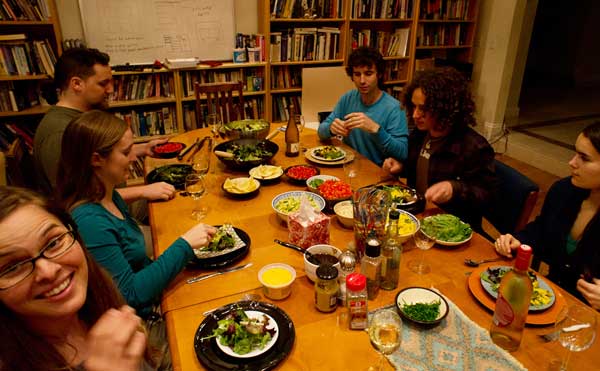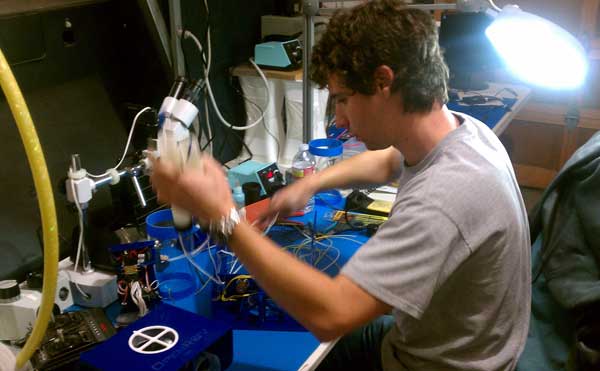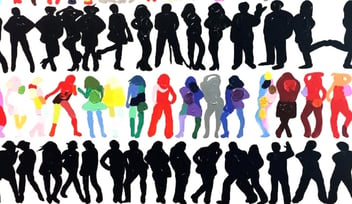Work/Life BLUR #3: Of Communes and CoLiving

How an exploding new trend borrows from the success (and can learn from the failure) of a flower power phenomenon.
We’re inquisitors and innovators and horrible thieves. A millennial obsession with all that is Old School has fueled unprecedented pilfering of “grandpa’s style” and shameless mining of the 1960s for their cool stuff. Beaded headbands, round glasses, feathers, fringe, facial hair, one-piece bathing suits, and vinyl records have renewed leases on our attention. Next up: communes.
At the nexus of coworking and real estate debuts coliving. As a lifestyle remix, it’s an easy sell: combine the ideological leftovers of 1960s intentional living communes with modern-day collaborative moxie. On one level, coliving can sound a lot like a commune, and does lean heavily on the some of the same buzzwords: community, intentionality, openness, experimentation, action, revolution. On another level, coliving looks quite different from the Sixties, with sharing and farming replaced by Post-It notes and technology. By all accounts, coliving is still peaking in popularity, but can it weather this first wave of trendiness? Only by assessing why communes of the past tanked can the co-living dynamic of the future survive.
To understand the reasons for their fall, it’s important to remember the cultural milieu that stewed up communes in the first place. Trying to do otherwise, to understand them out of context, is like saying you were “on the bus” when you really just looked through the window. The decade that we distill today into a tie-dyed shirt was really a juggernaut of cultural, spiritual, and political upheaval. Baby boomers came of age at a time when being American was unstoppable, inheriting a winning legacy on the heels of Armistice, wealth and strength. All they had to do was show up to inherit the keys to the kingdom, but some chose not to because the status quo went from being a noble bequest to a total drag. Blame Vietnam, civil rights, the pill, the music, the drugs, but what was a once a fringe faction of beatniks orbiting coffee shops had overflowed into society at large as a movement. When it came time to dress, or think, or create, the new generation broke the mold and got radical. When it came time to live, they did the same.
An entrepreneur and real estate mogul who lived in a Cambridge commune in the sixties describes it from the inside out. “No one called it a commune, they called it family.” The motivations to live alternatively were admittedly less economic than social, political and spiritual, and like many other aspects of this revolution, its members did not give two shits about the mainstream, never even really using the moniker “commune” to label themselves. They were family (no quotation marks).
To hear communes described in mass media is to realize the gulf between public perception and (altered) reality. The press painted them as doped-up sex fiends, as Communists getting loaded and freeloading until the drugs and tofu ran out. The most elegant disparagement of them came from Wallace Stegner: “they ignore both history and human nature… none wise enough to play God and create a human society.”
To hear communes described from the inside is starkly different: equal parts turning away (from traditions, stodginess, society, war) and turning on (to experimentation, openness, culture, and peace.) The media got it all wrong, and no one cared; they had their own newsletters, they had extended family across the country, they were united in their own counter-culture and as long as they “got it,” misconceptions by the olds were totally inconsequential.
There was not one single “type” of commune, but there were some commonalties between them. Whether agrarian or urban, anarchic or intentional, they all rejected traditional values, embraced community, valued humanity, rejected a corporate “master,” and believed that they could inspire change.
Sound familiar? Coliving invokes these same buzzwords from the upheaval of the sixties because it rekindles that radical spirit in the name of a wholly new paradigm. This time, it’s in the name of Business…wrapped in a lifestyle. Not unlike the backstory of the 60’s communes, the communal renaissance that birthed coworking emerged from a decades-old tableau. Perhaps coliving can do for the domicile what coworking did for the office. Because coworking works, coliving is hot. This is reshaping business and living, blurring the line between the two. Connectivity means that you’re never really off the clock, while community means you’re never completely on it. A widening swath of coworkers never really clocks out (or in), and has found its niche in a lifestyle choice straddling real estate and technology.
Unlike its forefather, the commune, the coliving experiment is the beneficiary of good press so far. Reports from afield paint a pretty favorable picture of success stories. The spaces themselves run the gamut from flophouse to convent, from secret to famous. Some accept bitcoin, some are silicon; some belong to parent companies and some are owned by self-described "catalysts.” Regardless of their flavor, these diverse spaces boast a common recipe: mix a powerhouse lineup of (preferably techy) individuals under one roof in a happing city, stir them with the belief in the collective, and charge for it. The sexiness of this idea is an easy sell, but can something as simple as a housing choice really impact one’s lifestyle and livelihood?
Rainbow Mansion says yes. More than a simple housing choice, this Silicon Valley residence is an “intentional community of driven, international, passionate, and socially conscious people trying to change the world.” Successful coliving pioneers here have embraced some of the 60’s ethos while putting the lessons of coworking into practice.
“The people at that time had different goals than we do,” confirmed resident Jeremy Swerdlow. “They wanted to build new society. We’re not looking to do that, or build a Utopia. We’re a little more basic, which is probably why we’ve survived. The people that did that had their civilization collapse.” So how does a “socially conscious” house change the world, then? “A lot people work hard to do something that is important. When you bring like-minded people together, you can communicate, you can collaborate, can share time together.” They also share Sunday dinners, Wednesday house meetings, and possibly a bit of a spotlight. “A lot of TV producers want to film here. There might be some TV coming out of this place!”
Already there have been more impressive things than television coming out of Rainbow Mansion. He explained how some of the products hatched in there have taken off. “Planet Labs, with their Cube satellites, now has a 200 million dollar valuation. A few years ago a resident made a very affordable underwater remote vehicle and went on to found Open ROV. Deep Space Industries is trying to mine asteroids. They were in our garage, but now they have an office in NASA!” When he says they were in Rainbow Mansion’s garage, he means that quite literally. Swerdlow has been fitting out the house’s garage with a hardware startup lab “with all the tools and equipment to do almost anything.”
As a testament to the Rainbow Mansion model of coliving, look no further than the proliferation of their spinoffs. Swerdlow confirmed, “there are several former residents doing it on their own. Everland spun off from Rainbow. So did Embassy in SF, and a third one coming up, but they’re still working on a name.”
Between the hard reasons of its economic model, and the soft reasons of its emotional appeal, several coworking companies have smelled success: WeWork and Neuehaus have already expanded into the coliving experiment. Part of coworking’s appeal is getting out of the house, so why would they invest in the house? Is it a conflict of interest, lifting an egg from your own golden goose? The implication here is that the blurring of home and office is so pervasive that modern entrepreneurs are seeking professional growth in their domestic collaborations, too.
The old school contingent is wary to jump in, waiting on the periphery of coliving until its initial buzz settles. Because it resembles something from college or camp, coliving suffers the same stigma as communes did when they were first assessed by outsiders and the media. But Cambridge Councilman Craig Kelley sees coliving, or something like it, as inevitable. “What we can’t do is live as I grew up- it’s not sustainable. We’re talking about people having tiny places to call their own, then sharing the communal. But the collective doesn’t work unless there are rules. Some people are big sharers on their own terms, so you need to be clear about the terms.” While this kind of caveat might have been overlooked in the 1960s, there’s no excuse for being so cavalier in this information age.
This sentiment was echoed by Swerdlow. “Coliving is growing. It has to be- we don’t really have much choice. The price of living is unbelievable. Even a well-paying tech job barely allows your existence.” To avoid the chaos of communal collapse, what kind of coliving rules keep the peace in his communal arrangement? “All big decisions have to be totally unanimous. One of the keys to making it work is that everyone has to say yes. The most critical thing is to have everyone on board.” The harmonious function of the Rainbow Mansion is no accident; the complicated application process of vetting hopeful residents reflects their commitment to the house community. “We’ve got a lot of events, so we have specific jobs. When everyone has jobs, most rules are not necessary. We don’t want bureaucracy.”
Now take heed. With so much borrowed from the Utopic motivations of communes, what lessons could their eventual collapse teach us?
There are many reasons for the dissolution of some communes. Accepted, pat culprits are greed, laziness, impatience, and questionable hygiene. However, the inside truth is more complicated, and a more relevant caveat. In the words of one former “family” member, things dissolved because “our twenties turned into our thirties.” With this came pressures to provide more than a subsistence-level of economic stability. After enough years coaxing change from within the commune, for many aging families a second look at mainstream society seemed less repugnant than it had a decade before. And there were two other forces at play: from the inside, hard drugs and children crashed the party. In his most poignant musing on why communes waned, the former (commune) family-man waxed poetic: “We lived like this because the times were changing. But then they kept on changing.”
Why might coliving fail? Some well-planned coliving houses, such as this one in Zagreb, Croatia, have already bloomed and died. Much of the blame falls on the tragedy of the commons and competition with cohousing (where common spaces sometimes get sacrificed to squeeze more bedrooms into the same cramped square footage). To keep coliving alive on the front lines of a fickle culture, then it must balance opposites: be organized yet adaptable, be communal without being campy.
Behind all this community-talk there’s an edge of competition driving the bus, a financial bottom line that was absent from the idyllic motivation of earlier communes. Where the end product of communes was spiritual enlightenment and social change, coliving stands to have longevity because it actually provides a product. Hardwired into the terms of coliving are safeguards against many of the pitfalls of the sixties commune: this is no place for children, bankruptcy or burnout.
The keen eyes of business and thought leaders are increasingly focused upon this iteration of the commune, and have coached it into the 2.0 version, coliving. If it survives its own pubescence, a veritable bandwagon will pounce on a piece of the action. The very real answers to the question of this experiment’s economic viability are answered by the bottom line. Have sleepovers, have hacking parties. Have meetings and recess.
But deliver.
Embrace the intersection of work and life through the Workbar blog’s new channel, “Blur“. Each installment explores new territory in the proving grounds of modern thought and culture in the workplace.
About the Author: Dave Gentry is a fan of progress and recess. He believes in old English, new fortune cookies and he answers to #davertido.
About Workbar:
Workbar operates coworking locations throughout greater Boston (Boston Back Bay, Boston South Station, Burlington, Cambridge, Arlington, Brighton, Danvers, Norwood, Salem) and several other partner locations throughout the state. Want to keep up with the world of Workbar? Subscribe to our mailing list for the most up-to-date information about our upcoming events and community news. You can also follow us on Instagram, Facebook, LinkedIn and Twitter.





